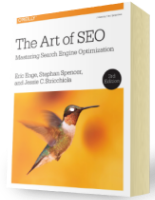Google Optimization: E-Commerce @ $1 Cost (Part 2)
Google Optimization: E-commerce @ $0 Cost (Part 2)
by Brian Klais
(As published in the December 2003 issue of Catalog Age Magazine)
Last time, we looked at why the Google phenomenon is changing e-commerce, and how merchants can get more product content indexed and visible to Google’s massive user base in order to sell Objective No. 3: Winning Clicks products @ $0 marketing cost.
There is much you can do to get your product page “sales force” in front of a prime audience. Once you do, it’s up to these pages to start selling themselves. If they are positioned on the first page of search results, the competition is usually narrowed to nine other listings. The next step is to convince the searchers that your product should be part of their consideration set. Your listings should start working for you here to weed out undesirable suspects while qualifying and compelling prospects to click open your catalog.
But remember, at that point your listings must sell on their own. You can’t assume the searchers are familiar with you. You can’t assume they’re looking for you. They’re not. They are looking for the best value regardless of what your CEO believes. Do you offer the widest selection? Free shipping on orders over $100? Lowest price? This listing should work to convince them why to buy from you. Whatever the reason, it must be clear in the link description.
Be sure to include qualifiers in your description text. If you’re Boise Cascade and you sell office products, you don’t want your listings attracting back-to-school shoppers. Part of the description should emphasize your B2B focus.
A balance must be struck between finding the words that will appease the engine for your topic as well as the users who find that page. Stuffing keywords into your pages may help them rank better for a variety of keywords, buy you would be sacrificing the warmth needed to convince someone to click open your site.
Objective No. 4: Selling @ $0
Once you win the click, your product becomes part of the consideration set. Now the real selling begins. Searchers click on at least four listings (according to BizRate), so your objective at this critical stage is to make sure that landing pages are prepared to win the sale faster than the competitors.
That’s easier said than done. If this page is the only impression the customer will have of you, what should it say? Of course, usability must be intuitive and functional. Does the design speak “ease-of-use”? If you are competing on selection, are you helping make connections and reducing thought time by showing related products, or items other consumers have purchased? (These are elements that can also help boost your Google rankings.)
What about guarantees or other ways to reduce risk for these strangers? Are there keyword-rich testimonials or discussion forums to help sell the standoffish searcher? (Notice the dual benefit here: cost-free, user-contributed content, written in natural vocabulary on a Google-friendly page that boosts rankings and helps sell.) Why not try closing the sale by serving up Google searchers a special price if they buy within the next 30 or 60 minutes?
For category or other non-product pages, a different competitive threat exists: Google itself. Suppose the consumer is searching for power drills. If they find a power drills sub-category page from Sears in the listings and click on it, that page must convince them that what they’re looking for can be found easier by continuing the quest at Sears.com than at Google.
What draws people to Google is its superior organizational value. If that page doesn’t convince the searcher that you offer more organizational value, your trusted source of referrals quickly becomes your enemy.
Objective No. 5: Applying Leverage
Once you’ve designed or optimized your site around these basic elements, you now have an infrastructure you can leverage into more advanced selling strategies.
Real-time promotions. Do you have frequent promotions? Google’s daily spider (known as freshbot) can push out those promotions into Google’s index. While competitor listings may have last month’s stale pricing, your Google listings could reflect today’s pricing, specials or offers to win the sale. Learning to leverage freshbot allows you to iterate change much faster.
Dynamic merchandising. Dynamic merchandising can be anticipated and planted into Google. Savvy marketers will monitor their internal search logs for the most popular keywords, then plant links to those most popular queries so Google can index them. Those dynamic pages are keyword-rich and merchandising-rich — an explosive selling combination. The guided search technology of Tower Records is a case in point. Searching for Van Halen albums presents an impressive array of albums and helpful organization schemes to help buy (who could have guessed the link between Van Halen and Christian Rock?). Imagine 40,000 people who search the Web for “Van Halen” finding these pages. By Tower providing added organizational value that expedites searchers’ quest, those searchers could be more likely to continue their quest at Tower Records instead of Google.
Exploiting Pay per Click. With a Google-friendly site infrastructure in place, keyword bidding, or pay-per-click programs can be treated more judiciously rather than as a sales dependency. Optimal keyword variations can be discovered and then applied to the site to fluidly extend your natural presence. Or bid spots can be used simply to influence clicks on natural listings to reduce costs.
Listing monopolies. Having multiple domains or sites that sell similar products can be leveraged to create listing monopolies. For example, companies like Eastbay that sell similar footwear products across a number of Web sites, such as Footlocker.com, WomensFootlocker.com, and others, can leverage these unique domains and their respective PageRank scores to monopolize listing pages for products like “women’s asics shoes.”
Conversations. Blogs and community tools are enabling a new conversational model of selling. Chances are, some obscure (or industry-specific) blog is discussing either your products or a need that your products can satisfy. Are you part of their reference set? Are you influencing the conversation by staking out keywords that you can brand and own?
There’s No Place Like Home
Many creative strategies are emerging to help merchants tap into this dynamic new search marketplace. As search becomes more embedded into consumer buying behavior, Google’s success provides both a framework and a reason for thinking about search engine friendliness as an integral part of Web design — rather than as an afterthought.
And this search dimension isn’t going away. Rather, its influence will soon bleed into other aspects of commerce such as product branding and offline marketing.
Of course, there are other engines to consider, and each has its own quirks. But, generally, designing the Web site to be Google friendly makes the site friendlier for other crawling engines, too. Diversification becomes important, as Inktomi expects to be integrated into Yahoo’s results. MSN’s crawler — MSNbot — scoured the Web last summer in preparation for an MSN-Google clash of the titans.
Meanwhile, open source projects like Nutch promise to open up the inner workings of a new scalable Google-esque engine. Still, at present, Google’s distribution and vast consumer loyalty present the single greatest opportunity and strategy for merchants to radically amplify the presence of the Web site, and to sell with no marketing costs.
What is the natural value of your product content? $5 per SKU per month? $20? $100? Can this be maximized? How do you fare against competitors? Who are your competitors? What are your opportunity costs? There are many new questions you need to answer.
One thing is clear: the success of Google has marked the convergence of Web site design and e-commerce marketing into a single discipline. Preparing for this paradigm shift requires a new, more holistic look at your e-commerce site to guarantee that search engines can pay dividends on your natural resources for a long time to come. The incredibly good news is that most retailers already posses in abundant supply the natural resources needed to capitalize on this opportunity.
See there? You’ve been wearing the ruby slippers all along, Dorothy. You just didn’t know what they could do for you.
Comments

Chapter 7:
Content Marketing
From the fundamentals of link building to the nuances of natural linking patterns, virality, and authority.
Related Posts

Thursday Three: Embrace Journaling, Tackle Tardiness, and Explore Our Energetic Echo
Here’s what I found inspirational, challenging, or just downright hilarious this week. What caught your eye? And, remember to check out this week’s great podcast episodes: Scaling a SaaS Company with Jason Morehouse “A crucial factor to business success is to find and take the personal path that works best for you.” — Jason Morehouse […]
Read More
Thursday Three: Harrison’s harmony, conquering a blank canvas, & gut health hacks
Here’s what I found inspirational, challenging, or just downright hilarious this week. What caught your eye? And, remember to check out this week’s great podcast episodes: Be a Sales Game Changer with Fred Diamond “True elite sales professionals develop a dedicated mindset, proactive client interaction, and continuous self-preparation. They understand their client’s needs and enable […]
Read More
Thursday Three: Rebirth of sleeper trains, 4,000 weeks is a long/short time, and golden age for medicine
Here’s what I found inspirational, challenging, or just downright hilarious this week. What caught your eye? And, remember to check out this week’s great podcast episodes: A Story Worth Retelling with Luke Storey “Aligned values are the cornerstone of successful partnerships, whether in business or life, as they shape our moral code, define our priorities, […]
Read More